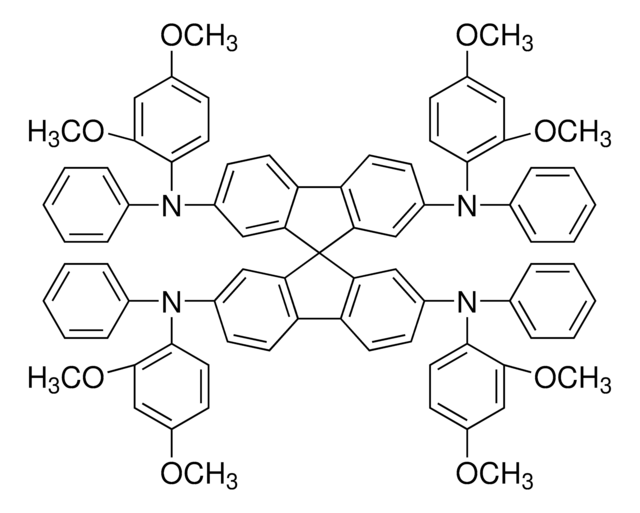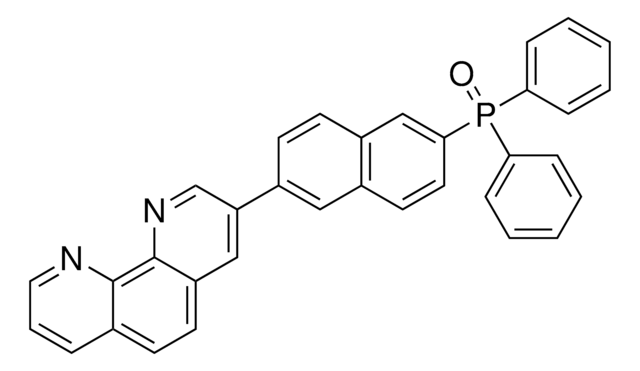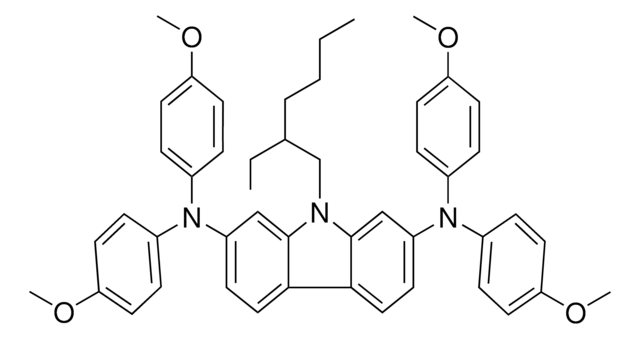Wichtige Dokumente
904899
Spiro[9H-fluorene-9,9′-[9H]xanthene]-2,7-diamine
Synonym(e):
N,N,N′,N′-tetrakis(4-methoxyphenyl)spiro[fluorene-9,9′-xanthene]-2,7-diamine, X59
About This Item
Empfohlene Produkte
Beschreibung
Band gap: Eg = 3.05 eV (lit)
Hole Mobility: 5.5 x 10-5 cm2/Vs (lit)
Assay
≥98%
Form
powder
Farbe
yellow
Leitfähigkeit
1.9 x 10-4 S/cm (lit)
Energie der Orbitale
HOMO -5.15 eV
LUMO -2.10 eV
SMILES String
N(c%10ccc(cc%10)OC)(c9ccc(cc9)OC)c1cc2c(cc1)c3c(cc(cc3)N(c8ccc(cc8)OC)c7ccc(cc7)OC)C42c5c(cccc5)Oc6c4cccc6
InChIKey
PDGJIZDXBRVKBB-UHFFFAOYSA-N
Allgemeine Beschreibung
Anwendung
Lagerklassenschlüssel
11 - Combustible Solids
WGK
WGK 3
Flammpunkt (°F)
Not applicable
Flammpunkt (°C)
Not applicable
Hier finden Sie alle aktuellen Versionen:
Analysenzertifikate (COA)
It looks like we've run into a problem, but you can still download Certificates of Analysis from our Dokumente section.
Wenn Sie Hilfe benötigen, wenden Sie sich bitte an Kundensupport
Besitzen Sie dieses Produkt bereits?
In der Dokumentenbibliothek finden Sie die Dokumentation zu den Produkten, die Sie kürzlich erworben haben.
Artikel
Professor Chen (Nankai University, China) and his team explain the strategies behind their recent record-breaking organic solar cells, reaching a power conversion efficiency of 17.3%.
Unser Team von Wissenschaftlern verfügt über Erfahrung in allen Forschungsbereichen einschließlich Life Science, Materialwissenschaften, chemischer Synthese, Chromatographie, Analytik und vielen mehr..
Setzen Sie sich mit dem technischen Dienst in Verbindung.
![Poly-[bis-(4-phenyl)-(2,4,6-trimethylphenyl)-amin] a poly(triaryl amine) semiconductor](/deepweb/assets/sigmaaldrich/product/structures/122/933/c34a34ab-284f-4890-adb8-126247a91d9b/640/c34a34ab-284f-4890-adb8-126247a91d9b.png)
![Spiro[9H-fluorene-9,9′-[9H]xanthene]-2,2′,7,7′-tetramine](/deepweb/assets/sigmaaldrich/product/structures/225/593/3b5858b3-0993-43eb-97ee-3f0d2a1142dc/640/3b5858b3-0993-43eb-97ee-3f0d2a1142dc.png)


![Poly[bis(4-phenyl)(2,4,6-trimethylphenyl)amine]](/deepweb/assets/sigmaaldrich/product/structures/288/293/16f2da62-4f58-4b77-926a-5bf2a96e0ad8/640/16f2da62-4f58-4b77-926a-5bf2a96e0ad8.png)


